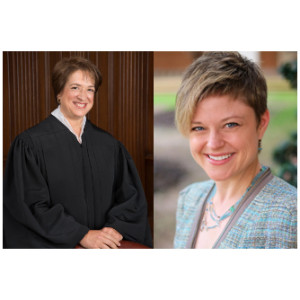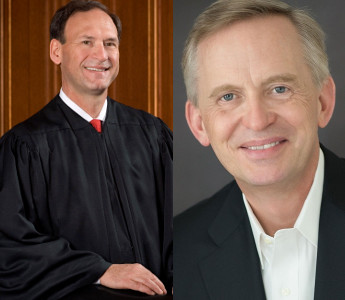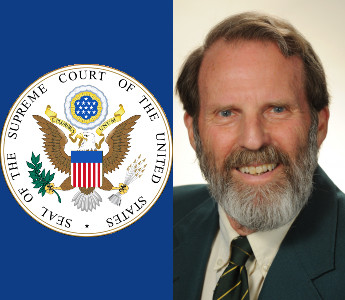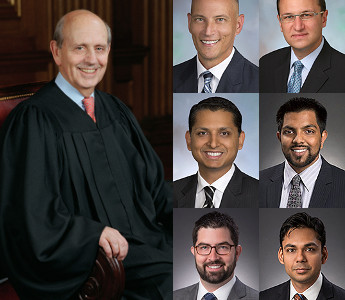FERC v. Electric Power Supply Association, 577 U.S. ___ (2016) (Kagan, J.).
Response by Professor Emily Hammond
Geo. Wash. L. Rev. Docket (Oct. Term 2015)
Slip Opinion | New York Times | SCOTUSblog
Energy Law’s Jurisdictional Boundaries: Staying the Course
Across the history of energy law, governance is an enduring theme.1 In the 1920s, the Supreme Court held that the dormant Commerce Clause barred states from regulating interstate sales of electricity.2 Given that the federal government did not regulate such sales, the decision left a regulatory gap—called the “Attleboro gap” after the case’s name. Congress structured the Federal Power Act (FPA) to close this gap, and the Supreme Court in FERC v. Electric Power Supply Ass’n (“EPSA”) confirmed that structure’s continuing viability.3
The case involved two questions. First was the Federal Energy Regulatory Commission’s (FERC) jurisdictional authority to set a uniform pricing scheme for demand response (DR) on the wholesale markets.4 Second was whether the agency’s selected pricing method was arbitrary and capricious. In this Response, I will provide a brief overview of the Court’s approach to each issue before providing some normative reactions to the opinion for both energy and administrative law.
Section 201(b) of the Federal Power Act (FPA) divides jurisdictional authority between FERC and the states but does not leave anything unregulated: for FERC, authority extends to wholesale sales of electricity in interstate commerce; states have regulatory authority over retail sales.5 FERC also has remedial authority under section 206 of the Act to correct “practices . . . affecting” jurisdictional rates when those practices cause such rates to be unjust and unreasonable.6 In Order 745, FERC reasoned that non-uniform DR pricing on the wholesale markets caused the wholesale rates to be unjust and unreasonable, and it grounded its authority to set uniform prices on its “practices . . . affecting” jurisdiction. The Electric Power Supply Association, which is a trade group for electric utilities (and stands to lose wholesale sales of power if demand is lowered by DR), challenged the order.
The wholesale/retail distinction sounds much clearer than it is. Indeed, the distinction is especially difficult to make in “mixed” cases—those in which practices can be characterized as involving both wholesale and retail activities—like DR.7 But in EPSA, the Court reached a sound conclusion in deciding that DR falls on the wholesale line such that Order 745 is within FERC’s remedial authority.
Writing for the majority,8 Justice Kagan explained first that the “practice . . . affecting” language should be construed to mean those practices that “directly” affect wholesale rates9—a test already endorsed by FERC,10 amici,11 commentators,12 lower courts,13 and the Court itself when construing similar statutes.14 DR, the Court reasoned, easily fell within those parameters “with room to spare.”15 The markets’ rules operate so that DR bids are dispatched only if they lower the wholesale clearing price by displacing more expensive generation. Further, DR promotes lower prices by avoiding congestion and enhancing reliability. Nor does Order 745 regulate retail, the Court decided. The Court emphasized the practical reality that “wholesale and retail markets in electricity, as in every other known product, are not hermetically sealed from each other.”16 Thus, the Court rejected the argument that Order 745 regulated retail sales because DR involves retail customers forgoing electricity use. With DR, the Court reasoned, FERC is merely regulating what takes place on the wholesale market as part of its mandate that the market be just and reasonable. Finally, the Court observed that if FERC could not regulate DR on the wholesale markets, then it could not be regulated at all—undermining the FPA’s purposes and creating a new regulatory gap.
Turning to the second question presented, FERC in Order 745 priced DR at the same value as generated electricity—the “locational marginal price” (LMP). EPSA and others argued that this price overcompensated DR resources because those customers were also saving money by not generating electricity, Citing the need to be especially deferential when reviewing an agency’s action within its technical expertise17, the Court had no trouble upholding FERC’s method.
The dissent, authored by Justice Scalia and joined by Justice Thomas, did more than expected by tepidly endorsing the “direct effect” test as a jurisdictional limit in “practices . . . affecting.”18 But Justice Scalia argued that the emphasis for the wholesale/retail divide should be not on the market where the transactions take place, but on the identity of the power purchaser—here, retail. Surprisingly, he also seemed to say that the FPA was not necessarily comprehensive in covering the entire field; rather, he contemplated that the statute could indeed contain a “minor” regulatory gap and provided some hypothetical examples in support.19
This reasoning—and the majority’s analysis—are important because the Court has granted certiorari on yet another dispute involving the FPA’s federal/state jurisdictional divide. The cases, consolidated under the name Hughes v. Talen Energy Marketing,20 concern whether the FPA preempts states’ efforts to subsidize generation resources—by making up for perceived deficiencies of the wholesale markets. Preemption is the other side of the FPA’s jurisdictional coin, and the Justice’s approaches to EPSA will surely bear on their reactions to this newest dispute. Oral argument is scheduled for February 26, 2016.
I close with two generalized observations from an administrative law perspective. First, EPSA involved an agency’s interpretation of its statutory mandate—and although under that rationale it might have been a candidate for Chevron analysis, the Court did not use it.21 The Court explained in a footnote, “[b]ecause we think FERC’s authority clear, we need not address the Government’s alternative contention FERC’s interpretation” is entitled to Chevron deference.22 For his part, Justice Scalia agreed that Chevron did not apply because, in his view, the statute clearly forbade Order 745. Taking this language with other recent Court statements on the matter,23 it almost seems possible to identify a trend toward more traditional, pre-Chevron approaches to interpreting regulatory statutes. That observation will almost certainly have relevance to how the parties approach challenges to the Clean Power Plan.24
Second, the Court’s approach to arbitrary-and-capricious review was of interest because it provides another data point in understanding the meaning of that standard. The Court’s generalized statements—which placed heavy emphasis on technical expertise and policy judgment—seemed consistent with a “super-deferential” approach to judicial review. I have previously argued that such an approach undermines the important role of the courts in incentivizing well-reasoned work at the agencies in the first instance.25 But the Court’s actual analysis seemed about right. Its discussion made clear that the Court had carefully worked to understand the pricing scheme. In setting forth that scheme for readers—whether the public, the media, Congress, public interest groups, or the electricity industry—the Court did the service of translating a very technical decision into a tractable opinion.26 As a result, monitoring this particular agency’s contribution to the administrative state is easier—and with luck, the Court will make this approach a trend for administrative agencies writ large.
Emily Hammond is the Associate Dean for Public Engagement and Professor of Law at The George Washington University Law School. She would like to thank Joel Eisen and Rob Glicksman for helpful comments. In the interest of full disclosure, she co-authored an amicus brief in this case that supported FERC jurisdiction. See Amicus Curiae Brief of Interested Energy Law Scholars on Behalf of Petitioners at 9 (FERC v. Elec. Power Supply Ass’n, S. Ct. filed July 16, 2015) (with Richard J. Pierce, Joel B. Eisen, and Jim Rossi), http://ssrn.com/abstract=263159. In a prior On the Docket entry, she responded to ONEOK, Inc. v. Learjet, Inc., 575 U.S. __, No. 13-271, slip op. (2015), and argued that energy law’s jurisdictional boundaries needed course correction. As the title here suggests, the Court’s latest foray into energy law suggests that it is back on track.
1. See Joel B. Eisen et al., Energy, Economics, and the Environment 8-9 (4th ed. 2015) (recurring themes are resource ownership, pricing and markets, externalities and risk, and governance).
2. Public Util. Comm’n of R.I. v. Attleboro Steam & Elec. Co., 273 U.S. 83 (1927).
3. FERC v. Elec. Power Supply Ass’n, 577 U.S. __ , No. 14-840, slip op. (Jan. 25, 2016).
4. DR is a generic term indicating that electricity users will curtail their usage on pre-determined conditions or in response to price signals. DR and the wholesale markets are explained more fully in EPSA, slip. op. at 4-9. See also Joel B. Eisen, Who Regulates the Smart Grid?: FERC’s Authority Over Demand Response Compensation in Wholesale Electricity Markets, 4 San Diego J. Climate & Energy L. 69, 70-85 (2013) (explaining DR in wholesale markets and debate over its compensation); Emily Hammond & David B. Spence, The Regulatory Contract in the Marketplace, 69 Vand. L. Rev. 141, 149-73 (2016) (describing the rise and operation of electricity markets and the grid).
5. 16 U.S.C. § 824(b)(1).
6. Id. § 824e(a).
7. Emily Hammond, Energy Law’s Jurisdictional Boundaries, Geo. Wash. L. Rev. Docket n.8 (April 28, 2015), http://www.gwlr.org/oneok-v-learjet/.
8. Justice Alito did not take part in the decision. Slip op. at 34.
9. EPSA, slip. op. at 15.
10. Order 745, 76 Fed. Reg. 16,658, 16,676, ¶112 (March 24, 2011).
11. Amicus Curiae Brief of Interested Energy Law Scholars on Behalf of Petitioners at 9 (FERC v. Elec. Power Supply Ass’n, S. Ct. filed July 16, 2015) (with Richard J. Pierce, Joel B. Eisen, and Jim Rossi), http://ssrn.com/abstract=2631599 [hereinafter Amicus Brief].
12. See generally Joel B. Eisen, FERC’s Expansive Authority to Transform the Electric Grid, 49 U.C. Davis L. Rev. __ (forthcoming 2016) (tracing history of “practices . . . affecting” jurisdiction and arguing for “directly affecting” test), http://ssrn.com/abstract=2671452.
13. See Amicus Brief, supra note 11, at 11-13 (collecting authorities).
14. See Schneidewind v. ANR Pipeline Co., 485 U.S. 293, 301 (1988) (“a natural gas company’s capital structure is related directly to the rates FERC allows it to charge”) (emphasis added); N. Natural Gas Co. v. State Corp. Comm’n of Kan., 372 U.S. 84, 92 (1963) (FPC has “authority to regulate the intricate relationship between the purchasers’ cost structure and eventual costs to wholesale customers who sell to consumers in other States”) (emphasis added).
15. Slip op. at 16.
16. Id. at 18.
17. Id. at 30.
18. Id. at 1 (Scalia, J., dissenting).
19. Id. at 7-8.
20. No. 14-614 (cert. granted Oct. 19, 2015). The case is consolidated with CPV Maryland, LLC. v. Talen Energy Mktg., LLC, No. 14-623.
21. Chevron U.S.A., Inc. v. Nat. Res. Def. Council, Inc., 467 U.S. 837 (1984).
22. Slip op. at 14.
23. E.g., Michigan v. EPA, 135 S. Ct. 2699, 2707 (2015); King v. Burwell, 135 S. Ct. 2480, 2488–89 (2015); Util. Air Regulatory Grp. v. EPA, 134 S. Ct. 2427, 2444 (2014).
24. See Emily Hammond and Richard J. Pierce, Jr., The Clean Power Plan: Testing the Limits of Administrative Law and the Electric Grid, — Geo. Wash. J. Energy & Envtl. L. –, at Pt.II.B. (forthcoming 2016) (demonstrating how a non-Chevron approach can be used to support EPA jurisdiction to issue the Clean Power Plan).
25. Emily Hammond Meazell, Super Deference, the Science Obsession, and Judicial Review as Translation of Agency Science, 109 Mich. L. Rev. 733 (2011).
26. See id. at 778-84 (making a normative argument for this approach).
Recommended Citation
Emily Hammond, Energy Law’s Jurisdictional Boundaries: Staying the Course, Geo. Wash. L. Rev. Docket (January 30, 2016), http://www.gwlr.org/ferc-v-electric-power-supply-assosciation-energy-laws-jurisdictional-boundaries-staying-the-course/.





